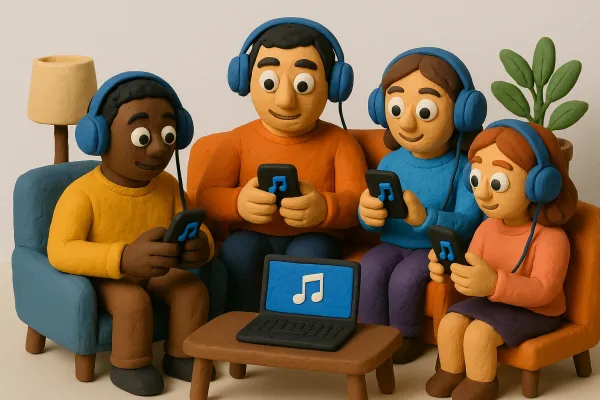The Ultimate Guide to Submit Music to Radio Stations for Maximum Airplay

Getting your music on the radio can be a game changer for any artist. It’s not just about airplay; it’s about reaching new audiences and building your brand. This guide will help you navigate the ins and outs of how to submit music to radio stations, ensuring you have the best chance of getting your tracks heard. From preparing your materials to finding the right stations, we’ve got you covered.
Key Takeaways
- Always keep your promotional materials updated.
- Make sure your music is professionally mastered before submission.
- Research and target the right radio stations for your genre.
- Craft a personalized pitch that highlights your unique sound.
- Follow up on your submissions to increase your chances of airplay.
Gather Your Promo Materials
Update Your Bio
When we start our promo journey, the very first thing we do is update our bio. This is where we explain who we are and what our sound is about, keeping it real and straight to the point. We always make sure it's updated with our latest info. In our bio, we drop details like our artist name, genre, and where we're based. Here's a quick checklist:
- Artist name
- Music style
- Location
We even like to sprinkle in a short mention of our Upload track details to let folks know where they can find more specifics. It's all part of keeping our message fresh and connected.
Collect Your Press Kit
Our press kit is like our all-in-one toolkit. We make sure we've got every piece together—from high-quality photos to music clips and even past interviews. When creating our kit, we cover a few standard points:
- High-quality, current photos
- Snippets of our best tracks
- Contact details for easy reach
- Prior media or interviews
Setting up our press kit takes a little extra time, but it really helps us shine when talking to radio folks.
Sometimes, we even put together a small table to keep our assets in check:
| Item | Status |
|---|---|
| High-res Photos | Ready |
| Music Clips | Current |
| Contact Info | Verified |
Organize Your Social Media Links
Social media is our go-to for staying visible and connected. We line up all our active profiles like Instagram, Facebook, and Twitter so that radio stations can easily follow and get to know us. Our routine here includes:
- Listing each platform's URL
- Making sure our branding is consistent
- Regularly updating our profiles
By keeping everything neatly organized, we ensure that anyone who checks us out gets the best picture of who we are as a band.
Prepare Your Music
Master Your Tracks
Our team works on making sure every track sounds polished and ready for the air. We spend time checking our mixes, balancing every element so it sounds clear and neat. We always consult with a trusted mastering expert to get that special radio sound. Here are some quick points we follow:
- Use a consistent mixing process.
- Check each track on different speakers.
- Compare current tracks with ones that are already on the radio.
We always make sure our tracks hit the mark on quality. Also, we like to keep an eye on the radio vibe to match what listeners expect.
Title Your Files Correctly
We believe naming files the simple way can prevent a lot of mix-ups. A proper file name not only looks neater but also meets many station guidelines. We suggest naming our files like this:
- Start with the song title.
- Add an underscore.
- Include your artist name.
For example, our table below shows a correct approach versus a mix-up:
| Correct Format | Incorrect Format |
|---|---|
| SongTitle_ArtistName.mp3 | ArtistName - SongTitle.mp3 |
| AnotherSong_OurBand.mp3 | OurBand_Another_Song.mp3 |
Sticking to this style avoids confusion when our music is reviewed.
Include Essential Metadata
We don’t skip on tagging our files. Every music file should come loaded with clear details like the song name, our band name, and even the album cover. We tend to include these bits of info:
- Song title
- Artist name
- Genre info
- Album artwork
Remember, our music file is often the first real peek a radio station gets into who we are as artists.
Taking care of metadata makes it easier for stations to classify and showcase our tunes. So, we always double-check that every file carries the right information before we send it out.
Find the Right Radio Stations
When we set out to get our tunes heard, we start by finding the right radio stations. It all begins with a mix of research and some good old-fashioned networking to make sure our music lands where it truly belongs.
Research Different Genres
We kick off by checking out different music styles and figuring out which ones might vibe with our sound. It’s not just about the loudest stations—sometimes the smaller, niche genres get us the best listener connection. Here’s what we do:
- Check out local charts and streaming playlists.
- Compare genre trends in different regions.
- Talk with fellow musicians and fans to see what’s hot.
This method not only helps us understand where our music fits but also gives us a chance to experiment with our style in different music circles.
Utilize Online Directories
Online directories are a goldmine of info when we’re trying to pinpoint stations to contact. We rely on these resources to quickly get essential details without wasting time. For instance, directories like direct access let us find the right contacts and submission guidelines in seconds. To make this even clearer, take a look at the table below comparing a few options:
| Directory | Genre Focus | Notes |
|---|---|---|
| Groover | Indie & Niche | direct access for quick contacts |
| Local Radio Hub | Regional Varieties | Good for community-based stations |
| Global Beats | Pop & Mainstream | Offers detailed submission policies |
We know that a personalized approach makes a huge difference, and having the right directories helps us target our efforts.
Connect with Local Stations
We also make a genuine effort to connect with local stations. It’s all about building that community feel and staying grounded. Here’s how we do it:
- Attend local music events and radio live events.
- Visit station websites or drop by if they’re nearby.
- Introduce ourselves at open mic nights or community mixers.
Getting to know people face-to-face and keeping it real can open doors that emails and forms simply can’t. This hands-on approach often leads to better placements on air.
By combining solid research with personal connections, we’re able to navigate the sometimes overwhelming process of finding the right radio stations. It isn’t always pretty, but it sure works when it comes to spreading our tunes around.
Crafting Your Pitch
Personalize Your Message
We like to keep things real when we write our pitch for radio. We always take time to tweak our message for each station we reach out to. We know our audience and speak their language, keeping things clear and direct. Our approach is simple: we check out each station’s style, tailor our greeting, and mention a couple of things that show we aren’t just sending a mass email. Here’s a quick list of our steps:
- Look up the station’s vibe and music genre.
- Address the right person by name.
- Drop in a note that shows we did our homework.
And, of course, our journey through radio submissions has taught us the value of treating every message like a one-on-one conversation.
Highlight Your Unique Sound
Our music is our calling card, and we make sure to spotlight what sets us apart. When we write this part of our pitch, we focus on a few standout points such as:
- Our catchy hooks that stick around.
- The energy and feel we bring to the track.
- The blend of unique instruments and rhythms that make our tunes unmistakable.
Below is a simple table that sums up our favorite points of difference:
| Pitch Element | How We Explain It |
|---|---|
| Unique Style | Fresh rhythms and cool hooks |
| Authentic Expression | Real, down-to-earth vibes |
| Signature Sound | That one-of-a-kind beat |
Keep It Short and Sweet
We know that time is short, so we keep our pitch tight and to the point. Our goal is to give just enough info without overwhelming the reader. Our process includes:
- Starting with a friendly, brief opening.
- Listing our main features in a clear, bullet-point style.
- Ending with a clear question or a simple call to action that invites further chat.
We keep our messages clean and simple because getting to the point matters to those who read our pitch.
Timing Your Submission
Understand Programming Schedules
We like to keep track of radio show cycles and formats because it gives us insight into when our tunes might really stand out. We usually look at:
- Daily show timings
- Genre-based time slots
- Special event or seasonal changes
Staying aware of the schedule means we can plan our push when listeners are most engaged.
Submit During Key Times
We’ve found that sending our music during less busy hours can make our track the center of attention. Submitting during quieter radio hours can really make our work pop. Here's a quick table we put together to pinpoint ideal time slots:
| Time Slot | Why It Works | Our Take |
|---|---|---|
| Morning Drive | Steady commuter listenership | Great for a fresh start |
| Midday | Fewer submissions in the mix | A perfect window for a focused pitch |
| Late Night | Niche but loyal audience | Ideal for experimental or relaxed tunes |
Remember, a well-timed send can give you that extra edge with airplay tips.
Follow Up After Submission
Once our music is sent off, we chill for about two weeks before reaching out again. Our follow-up routine includes:
- A short, friendly check-in email
- Sharing any fresh updates or new releases
- Asking if additional details are needed for a smoother decision process
This approach not only keeps our communication smooth but also helps us learn what works best moving forward.
Monitor Your Airplay
Keeping an eye on our airplay is a fun and informative process. It helps us understand where our tunes are hitting and what listeners think about them. Below, we break it down into three easy-to-follow areas:
Track Where Your Music Is Played
We like to know exactly which stations are spinning our tracks. To sort this out, we use simple tools and even review some radio tracking data which gives us clarity on our station list. A quick table can sum up what we’re looking for:
| Station Name | Number of Plays | Region |
|---|---|---|
| Local FM Station | 15 | Metro Area |
| Indie Radio | 8 | Suburbs |
| Community Network | 5 | Rural Area |
This table gives us a quick visual of where our music is being played. It’s straightforward and makes follow-ups easier.
Analyze Audience Feedback
Once we spot which stations are playing our music, we jump into figuring out the listener response. We check social mentions, call-ins, and listener surveys for clues. Here’s how we usually dig into it:
- Read feedback from local shows
- Monitor social media chatter
- Look at audience calls and messages
We know that tracking airplay gives us real-time insights into listeners' habits. Don’t forget to also check out radio tracking data for extra detailed figures that can help us improve our reach.
We often talk about our results during team hangouts. It lets us adjust our game plan and keep improving our sound and delivery.
Adjust Your Strategy Accordingly
Our next step is simple: use the numbers and feedback to rework our plans. If one station’s response is off, we tweak our pitch or see if another station might be a better match. We keep our process agile, and here’s a quick checklist we follow:
- Review the performance data every week
- Hold a quick team meeting to discuss any changes
- Experiment with slight adjustments in our approach
By continuously checking in with our metrics and revisiting radio tracking data from time to time, we ensure our music gets the best shot at success. This isn’t just about numbers—it’s about connecting with real people who enjoy our tunes.
Consider Professional Help
We've been thinking about how we can really give our music the best chance at radio play. Sometimes, handling everything ourselves can feel like too much, and that's when we consider professional help.
Working together often makes the whole process smoother and less stressful.
Hire a Radio Promotion Agency
Working with an agency can really lighten our load. They know the ins and outs of the industry and can connect us with the right people. Here are a few ways an agency helps:
- They bring industry relationships that we might not have on our own.
- They streamline the process of submitting our music to stations.
- They offer insights from years of practical experience.
Teaming up with an agency can sometimes be the quickest way to get noticed. We even found that reaching out to an independent promoter adds extra credibility to our efforts.
Work with a Virtual Assistant
Virtual assistants can be a lifesaver when it comes to managing the endless details. They help us keep track of submissions, update our contacts, and remind us of follow-ups. Some of our favorite tasks to delegate include:
- Scheduling submission dates and follow-up calls.
- Organizing our promo materials and deadlines.
- Keeping our contact lists clean and updated.
This setup lets us concentrate on the creative side while someone else handles the admin work.
Invest in a Contact Database
A good contact database can be our secret weapon. It simplifies how we find the right stations and DJs to reach out to. Here’s a quick look at what we should look for in a database:
| Feature | Benefit |
|---|---|
| Up-to-date info | Saves us time |
| Customizable | Easy to filter stations |
| Filter options | Better targeting |
By keeping our contacts sorted and accessible, we ensure our submissions reach the right ears every time. In our experience, a good database is as important as having the best track in our lineup.
If you're feeling stuck or overwhelmed, it might be time to reach out for some help. Professional support can make a big difference in your journey. Don't hesitate to visit our website for more resources and guidance. We're here to help you every step of the way!
Wrapping It Up
So, there you have it! Submitting your music to radio stations doesn’t have to be a headache. Just remember to keep your promo materials sharp, your tracks sounding great, and don’t forget to follow those submission guidelines. It might take some time and effort, but with a little persistence, you can get your tunes out there. And hey, if you hit a wall, don’t hesitate to reach out for help. Whether it’s a friend or a pro, sometimes a fresh set of eyes can make all the difference. Now go on, get your music heard, and who knows? You might just find yourself jamming on the airwaves before you know it!
Frequently Asked Questions
What materials do I need to submit my music to radio stations?
You should gather your biography, photos, a press kit, and links to your social media accounts. Make sure everything is current.
How can I prepare my music for submission?
Make sure your tracks are professionally mastered, name your files properly, and include important information like the song title and artist name.
How do I find the right radio stations for my music?
Look for stations that play your genre, use online directories, and connect with local stations to find the right fit.
What should I include in my pitch to radio stations?
Make your message personal, emphasize what makes your music special, and keep it brief.
When is the best time to submit my music?
Know the programming schedules of stations, submit during busy times, and follow up after you send your music.
Should I hire someone to help me with radio submissions?
Yes, hiring a radio promotion agency or a virtual assistant can help you manage submissions and save time.





